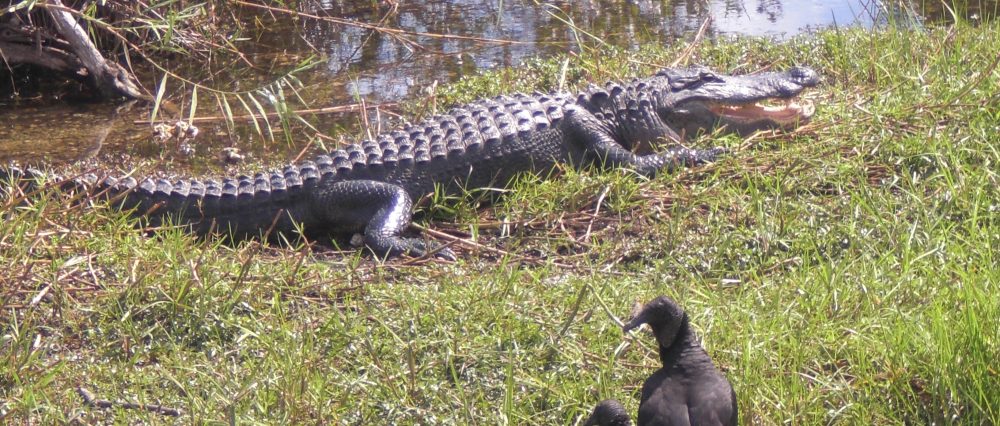Reporters struggle to get it right in reporting on the Everglades
By Olivia Balsinger
Burmese pythons slither and slink unseen through the Everglades sawgrass. Alligators, slyly glide throughout the vast swamps. The Florida panther, once a prominent symbol of the Everglades and now endangered, roams carefully. Those who attempt to catch sight of the wildlife in the Everglades must look long and hard, paying careful attention to detail, in order to succeed.
And that is exactly what reporters hoping to cover the Everglades must do as well.
Because the Everglades have such an enormous role within South Florida and its environment, it is easy for journalists to lose focus on the larger picture surrounding the Everglades.
The stories that tend to dominate the press are narrowly focused—whether they are covering a press conference, the plethora of political opinions of the swamp, or even court cases.
But what can go sometimes missing is the bigger picture.
“It’s such an enormous topic that it’s really hard to wrap your mind around it, much less boil it down into a story,” said Craig Pittman, a reporter for the Tampa Bay Times. “You’ve got a billion different angles you can take, and you’ll never quite get it all down.”
One journalist who did find a way to rise above the daily stories of the Everglades was Michael Grunwald, who in 2002 wrote an in-depth reporting series on the restoration progression for The Washington Post. He also was part of year-long investigation of the Army Corps of Engineers of South Florida that won the George Polk Award for national reporting.
Neil Santaniello teaches environmental journalism at Florida Atlantic University’s Jupiter campus and before 2006 he was an environmental reporter for the South Florida Sun Sentinel.
Santaniello agrees that the Everglades is quite difficult for journalists to cover. He said, “There are a lot of endangered species and plants in the world, but the Everglades is a 100-pound gorilla.”
Pittman has been writing Everglades stories since given the specific beat from the Times in 1998. He has written about the Miccosukee Tribe’s role in the Everglades’ battles and how Tamiami Trail, a highway connecting Tampa and Miami, acts as a dam in blocking water flow. He also concentrates on the pollution in Lake Okeechobee and the politics of restoration.
With all the angles Pittman has already covered, he stresses that there is much that still needs coverage. He said, “There are still plenty of stories I’d love to write that I just haven’t had time to do. Yet.”
“As a journalist, it is a challenge primarily because the Everglades beat is so long-term,” said Santaniello. “There are lot of politics involved with the Everglades, and so the restoration project globally has become very symbolic.”
“This is not a local story,” he continued. “It is an ecosystem being watched all over the word.”
Since 2000 much of the news coverage has concentrated on the now $13 billion federal and state Everglades restoration effort. The plan includes more than 60 elements, and it will take more than 30 years to construct.
“The restoration is far from done. In fact it’s only getting started, and already it’s faltering,” said Pittman. “The funding from the federal government sputtered out shortly after it started, but now it’s cranked back up again. Meanwhile the state’s funding kept the thing going but now it’s sputtering. And if it dies, then there’s not going to be a sufficient water supply for South Florida’s future.”
In addition, those who write for the Everglades beat must understand the enormity of a spectrum they must cover. Santaniello explained that his beat of the Everglades covers a plethora of issues; these stories become much more complicated than just necessary to be covered for a year or two. Said Santaniello, “I had to talk to science, had to listen to politicians, and pay attention to the sugar industry.”
The audience for the Everglades beat is also quite different than the average reader. Many of the people who read about the Everglades, Santaniello explained, would hardly venture into the swamp themselves. Instead, they either currently live in, or are native to, South Florida and feel it is necessary to understand what is happening within the Everglades because it is so iconic.
In addition to catering stories that a mixed variety of readers would be interested in, another difficulty reporters face is constantly keeping the stories and information fresh and varied.
“We don’t have scandal, power and politics in the industry like some other beats get to rely on,” said Santaniello. “We don’t want to miss day to day development, though it is always negativity that will spread the fastest. At the end of the day, you have to be able to connect it to the people. You have to give drama. You have to find a story and look for things that people for care about. What you have to do is be of great service to the readers.”
Coverage, Santaniello explained, has also suffered to a degree because of the cutbacks in the number of journalists at newspapers and television stations throughout Florida after the 2008 recession.
As for the future of journalists covering the Everglades beat, Pittman has some hopeful news. “Coverage will continue, but whether it will increase or just stay the same I cannot predict,” he said. “While the number of newspapers doing environmental coverage has dropped, the gap has been filled by non-profits and web-only operations…there’s a lot of good, sophisticated environmental reporting still being done, the kind that has a real impact.”


